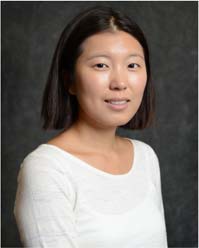
Recent advances in autonomous vehicles (AVs) will soon transform carsharing system paradigm. It is expected Autonomous Car-Sharing Systems (ACSS) will serve more trips than current peer-to-peer ridesharing or taxi systems. However, fully relying on ACSS may not always be beneficial for both the service operators and the overall transportation systems due to fleet cost and relocation requirements. This talk will present a time-space optimization model for service design and operations of future ACSSs that determines the optimal fleet size, service level, and vehicle operations. The proposed model explicitly considers empty vehicle relocation and the demand shift between ACCS and privately owned AVs. We develop methodologies based on Benders decomposition to handle the computational challenges.
Dr. Jee Eun (Jamie) Kang is an Assistant Professor with the Department of Industrial and Systems Engineering at University at Buffalo, New York. She received her Ph.D. degree in Transportation Systems Engineering from University of California Irvine in 2013. Her research interests include applied operations research and transportation systems modeling. Her current research focuses on adoption of autonomous vehicles, and big data analytics for transit operations in addition to continuing works in adoption of alternative fuel vehicles, and disaster operations management. Her research activities are supported by the National Science Foundation, Region 2 Transportation Research Center, TransInfo University Transportation Centers, and Korea Transport Institute. She was a recipient of Women’s Transportation Seminar graduate scholarship in 2012, and was selected as an Eno Fellow in 2013.

Recent transportation network studies on uncertainty and reliability call for modeling the probabilistic O-D demand and probabilistic network flow. Making the best use of day-to-day traffic data that are collected over many years, this research develops a novel theoretical framework for estimating the mean and variance/covariance matrix of O-D demand considering the day-to-day variation of network flow induced by travelers’ independent route choices. It also estimates the probability distributions of link/path flow and their travel cost where the variance stems from three sources, O-D demand, route choice and unknown errors. The framework estimates O-D demand mean and variance/covariance matrix iteratively, also known as iterative generalized least squares (IGLS) in statistics. Lasso regularization is employed to obtain sparse covariance matrix for better interpretation and computational efficiency. Though the probabilistic O-D estimation (ODE) works with a much larger solution space than the deterministic ODE, we show that its estimator for O-D demand mean is no worse than the best possible estimator by an error that reduces with the increase in the sample size. The probabilistic ODE is examined on two small networks and two real-world large-scale networks. The solution converges quickly under the IGLS framework. In all those experiments, the results of the probabilistic ODE are compelling, satisfactory and computationally plausible. Lasso regularization on the covariance matrix estimation leans to underestimate most of variance/covariance entries. A proper Lasso penalty ensures a good trade-off between bias and variance of the estimation. I will also briefly discuss several other research projects regarding transportation system analysis and optimization at the Mobility Data Analytics Center (MAC) at CMU.
Zhen (Sean) Qian is an Assistant Professor jointly appointed at the Department of Civil and Environmental Engineering (major) and Heinz College of Information Systems and Public Policy (minor) at Carnegie Mellon University (CMU). He directs the Mobility Data Analytics Center (MAC) at CMU. Qian’s research lies in the integration and optimization of civil infrastructure systems. The primary focus of his research is to manage aging and overcrowded transportation infrastructure systems, and to build sustainable and resilient infrastructure networks through large-scale data analytics. He is particularly interested in large-scale dynamic network modeling and big data analytics for multi-modal transportation systems, in development of intelligent transportation systems (ITS) and in understanding infrastructure system interdependency. His research has been supported by multiple agencies and private firms, such as NSF, FHWA, Pennsylvania Department of Transportation (PennDOT), Pennsylvania Department of Community and Economic Development (DCED), IBM, Benedum Foundation, and Hillman Foundation. Prof. Qian serves in the editorial board of Transportation Research Part C and Transportmetrica B, and is an active member of the Network Modeling Committee of Transportation Research Board. He is the recipient of the 2017 Greenshields Prize from the Transportation Research Board. Qian was a postdoctoral researcher in the Department of Civil and Environmental Engineering at Stanford University from 2011 to 2013, and received his PhD degree in Civil Engineering at the University of California, Davis in 2011 and his M.S. degree in Statistics at Stanford University in 2012.

Fully-autonomous vehicles (AVs) have the potential to fundamentally alter urban passenger transportation systems. My research focuses on shared-use AV mobility services (SAMSs), which are similar to existing taxi, ridesharing, and paratransit services, except that the vehicles are driverless. As AVs eliminate the labor costs associated with human drivers, SAMSs should be able to compete with the personal vehicle in terms of cost and convenience for nearly all trip purposes.
In this talk, I will define an on-demand SAMS, conceptualize the underlying problem associated with operating this service, describe the framework used to model the online problem, and then present and compare solution algorithms (i.e. control policies). I will highlight the uniqueness of the on-demand SAMS operational problem relative to the existing literature.
Additionally, I will present a systems-level modeling framework I am developing to analyze the impacts of SAMSs on transit demand and transit network performance. The modeling framework incorporates a time-dependent integrated mode choice-traveler assignment problem formulation, a discrete-event transit simulation tool, and an agent-based SAMS simulation tool. This integrated simulation-based modeling framework is a powerful tool for understanding, forecasting, and planning for the potential impacts of SAMSs on existing transit systems.
Despite the potentially sizable impacts of SAMSs on urban transportation systems, research at both the operational level and systems level is in its infancy. As such, I will discuss potential future research avenues at both the operational level and the systems level.
Michael Hyland is a 5th year PhD candidate in Civil and Environmental Engineering (CEE) at Northwestern University studying transportation systems planning and analysis. He holds a B.S. and an M.Eng. in CEE from Cornell University where he studied transportation systems engineering. Michael’s research focuses on modeling, optimizing, simulating, and analyzing multimodal transportation systems, with an emphasis on emerging mobility services such as bikesharing, carsharing, ridesharing, and shared‐use autonomous vehicle (AV) mobility services. He is a two‐time recipient of the Dwight David Eisenhower Transportation Fellowship, was named a Top 20 Future Leader in Transportation by the Eno Center for Transportation in 2016, and was awarded best student paper (runner‐up) at the 2017 Transportation Research Forum Conference.

A concept of equilibrium has been widely used to describe a congested transport system. For an equilibrium solution to be realized in the real world, it must be a stable solution, i.e. it must be robust against small noises onto the system. Recent studies have mentioned that a solution may not be stable in models including delays at a bottleneck. If there is no stable equilibrium solution in the system, we need to analyze a day-to-day dynamics to assess how the status of the system is changing over days. This talk introduces theoretical and numerical analyses of the day-to-day dynamics in a transport system to assess whether it is stable or not and how it is affected by adjustment process of travelers’ behavior, especially information collection behavior.
Takamasa Iryo is a professor of Kobe University, Japan. He received Dr. Eng. (civil engineering) from the University of Tokyo in 2002. After working as a post-doc fellow, he moved to Kobe University as a research associate in 2003. He was then promoted to an associate professor in 2010 and a full professor in 2013. He is an ISAC member of the international symposium on dynamic traffic assignment since 2010 and an associate editor of Transportmetrica B since 2013. His research topics include dynamic traffic assignment, big-data analysis for transport systems, and implementation of a traffic simulator for a large-scale network in a high-performance computer.
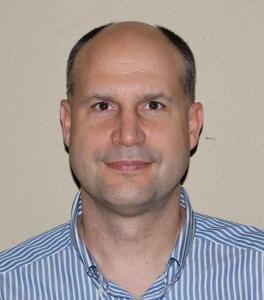
This seminar will introduce the concepts of both Connected Vehicles and Autonomous Vehicles, and describe the vision for the merging of both aspects into Connected Automated Vehicles (CAV). Following the brief introduction, the seminar will describe a series of national coalitions, working groups, and initiatives that are advancing CAV at the state and local levels. Emphasis will be placed on the SPaT Challenge – an AASHTO Resolution to challenge state and local infrastructure owners and operators to deploy approximately 20 Dedicated Short Range Communications (DSRC) based Signal Phase and Timing (SPaT) broadcasts at signalized intersections in every state by 2020.
Dean Deeter is President, and responsible for technical operations of, Athey Creek Consultants, based in Portland, Oregon. He has more than 25 years of experience in planning, design, operations and valuation of technology solutions for transportation,with an emphasis on Systems Engineering, Traveler Information, Connected and Automated Vehicles, and Rural Initiatives. Dean provides technical support to the national Vehicle to Infrastructure Deployment Coalition, the Connected and Automated Vehicle Executive leadership team (CAV-ELT), and the Infrastructure owners/operators (state and local DOTs) Forum of Collaboration with the OEMs (involving about 9 automobile manufacturers). Dean has a Bachelor’s degree from Colorado State University and a Master degree from the University of California, Irvine. He is a registered Professional Engineer in Minnesota and Oregon.
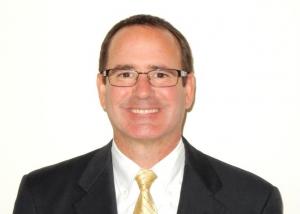
In recent years a variety of innovative transportation services have emerged to address transportation demands that are not being met by traditional fixed-route transit service providers. Collaboration with these innovative services offer opportunities for the transportation industry to expand mobility in ways that transit agencies have never before contemplated.
Due to changing demographics, environmental pressures, fiscal constraints, and the fast-paced innovation of the technology sector, the public transportation industry must find creative new solutions to provide mobility options. It must engage partners from the public and private sectors to increase access and connectivity to fixed route service, and provide service in areas where population density or ridership does not justify a public transit investment. Doing so will expand the reach and effectiveness of transit, thereby maximizing mobility and mode share in the community.
There are numerous challenges that must be overcome before these partnerships can become a reality. One of the primary impediments is the inability of regulations to keep pace with technological advancements. This is evident in the lively discussion in regard to Autonomous Vehicle testing and how to best integrate AV technology into the current and ongoing regulations from the California Department of Motor Vehicles.
Lloyd Sullivan is a Department Manager for the Orange County Transportation Authority (OCTA) overseeing the Offices of Innovation and Project Management. Lloyd has twenty years of experience working in Public Transportation, Project Management and Information Systems. Lloyd has a Bachelor of Science degree in Business Administration from Bryant University and a Masters of Business Administration from the University of New Hampshire. Throughout his career Lloyd has been active with the Project Management Institute (PMI) and earned his Project Management Professional (PMP) certification in 2000. Lloyd also holds an Advanced Master’s Certificate in Project Management from the George Washington University. Lloyd participated in the American Public Transportation Association (APTA) Leadership program in 2015 and co-authored a white paper titled, “Collaborative Mobility”. He presently resides in Mission Viejo, California with his wife, Carrie and their two sons, Liam and Aiden. Lloyd received his private pilot’s license in 2006 and his hobbies include flying and golf.
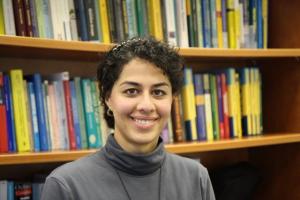
We describe a Markov-chain-based approach to modelling multi-modal transportation networks. An advantage of the model is the ability to accommodate complex dynamics and handle huge amounts of data. The transition matrix of the Markov chain is built and the model is validated using the data extracted from a traffic simulator. A realistic test-case using multi-modal data from the city of London is given to further support the ability of the proposed methodology to handle big quantities of data. Then, we use the Markov chain as a control tool to improve the overall efficiency of a transportation network, and some practical examples are described to illustrate the potentials of the approach.
Mahsa Faizrahnemoon received her M. Sc. Degree in Applied Mathematics from Chalmers University of Technology/ University of Gothenburg in Gothenburg, Sweden in 2012. She received her Ph.D. from the Hamilton Institute at the National University of Ireland Maynooth in Maynooth, Ireland in 2015. Her PhD thesis was about optimizing and modelling Intelligent Transportation Systems and her paper won the best scientific paper award of the European ITS Congress in 2013 in Dublin, Ireland. She has been a Postdoctoral Fellow at the Department of Mathematics at Simon Fraser University since January 2016. She has been active in industrial projects in collaborative mobility, including smart transportation and public transportation networks, as well as production channel scheduling. Her main field of theoretical research is optimization and operations research.

Despite decades of calls for better and more comprehensive demand models of long-distance and intercity travel, most researchers and practitioners remain largely focused on daily travel within home regions. The more sophisticated models, often driven by household activity pattern data, are used to simulate multimodal trip tours within our large metropolitan regions, while arrivals and pass-through traffic from out-of-region and out-of-country are only considered as aggregate exogenous factors. Long-distance travel in the United States is estimated to include more than 2.6 billion trips annually and to potentially comprise more than 30% of person miles of travel. Its importance will only increase as US mega-regions grow and both interstate highway and airport congestion continue to escalate.
This seminar will reflect on the historic context and motivators of long-distance travel and how 21st century telecommunication and transportation systems have increased mobility. The seminar will draw on a range of unique data sources, including a one-year online panel survey and mobile phone traces. Our findings illustrate long-distance tour complexity: 1) mixed purposes between stops as well as at individual stops occurred in 14% of tours; 2) spatial complexity including multiple chained stops as well as out-and-back from a hub other than home occurred in 20% of tours accounting for 46% of the miles; and 3) different primary modes on different legs of the long-distance tours were used in 11% of cases. Total long-distance trips rates, air trip rates and leisure trips rates are lower for African Americans and Hispanics, people without college degrees, and those with lower household incomes. These results point to inequity in access and mobility but also a skewed distribution of the carbon emissions across the population for long-distance travel.
Understanding and forecasting long-distance travel is important for infrastructure, economy, equity, and environment. Our research findings are critical to informing meaningful data collection to move forward towards national and global travel forecasting models. In an age of increasing reliance on passive mobile data sources, there remains a strong argument to complement “big data” with traditional household travel surveys for advancing models of long-distance intercity passenger travel.
Dr. Lisa Aultman-Hall is a Professor of Civil and Environmental Engineering at the University of Vermont. Her research focuses on collection of innovative data to study long distance travel, tailpipe emissions, and bicycling as well as modeling system resiliency especially as it relates to planning for climate adaptation. Dr. Aultman-Hall is active with the Transportation Research Board of the National Academies including a task force on national travel data needs and recently starting a new subcommittee on inter-city travel. Dr. Aultman-Hall is one of the Associate Directors of the National Center for Sustainable Transportation a USDOT UTC led by the University of California Davis. She is a Visiting Scholar at UC Davis this year.
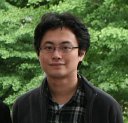
The fundamental diagram (FD), also known as flow–density relation, is one of the most important concepts in traffic flow theory. It would be valuable if an FD could be calibrated by GPS-equipped probe vehicles; since they can continuously collect data from wide spatiotemporal area compared to traditional fixed sensors. This study proposes methods for calibrating an FD from trajectories of sampled vehicles. We formulate a method that identifies values of a free-flow speed and a critical density of a triangular FD, while it relies on exogenous assumptions on FD’s functional form and a value of its jam density. Then, a heuristic algorithm for FD calibration in actual traffic environment is developed based on the proposed method. It was validated using actual traffic data on highway. The results suggested that the proposed methods can calibrate an FD under certain conditions. It implies that FDs in road sections on which congestion happens frequently can be calibrated using probe vehicles, if probe vehicle data were collected for a long period.
Dr. Toru Seo is a postdoctoral researcher at Tokyo Institute of Technology where he received Dr.Eng. degree in 2015. His research interests include transportation data collection, estimation, and application of traffic flow theory. He received the Best Paper Award at the IEEE 18th International Conference on Intelligent Transportation Systems, Kometani-Sasaki Award for Dissertation, and several Japanese awards.
Website: http://www.csis.u-tokyo.ac.jp/~t.kusakabe/index_en.html
Google Scholar: https://scholar.google.com/citations?user=4Kt60z4AAAAJ&hl=ja

Traffic flow monitoring is one of the important processes of road traffic managements. With the improvement in information technology systems, many sensors such as traffic detectors and probe vehicles generate large amounts of traffic flow data. Recent spreading of probe vehicles enable us to observe dense and wide-ranging road network. They are expected to include a huge amount of incidents or unusual situations that are usually overlooked.
This study introduces incident detection method which can detect incidents which influence large area in the network. The method is applied to the massive probe vehicle dataset which is collected by about 40000 commercial vehicles all over Japan for one year.
Dr. Takahiko Kusakabe received the Dr.Eng. degree from Kobe University, Kobe, Japan. He was Research Fellow (DC2) and (PD) of Japan Society for the Promotion of Science, Assistant Professor at Tokyo Institute of Technology, and is currently Assistant Professor at the Center for Spatial Information Science, the University of Tokyo. He received the Best Paper Award at the IEEE 18th International Conference on Intelligent Transportation Systems and Young Scholar Paper Award from Japan Society of Civil Engineers.
Website: http://www.csis.u-tokyo.ac.jp/~t.kusakabe/index_en.html
Google Scholar: https://scholar.google.com/citations?user=4Kt60z4AAAAJ&hl=ja








